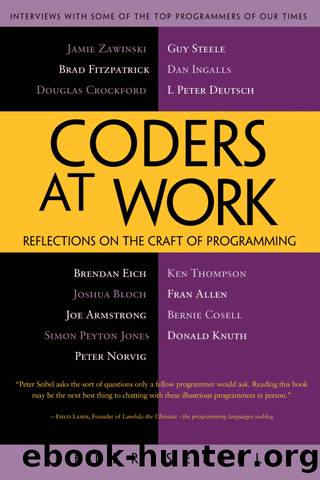Coders at Work: Reflections on the craft of programming by Peter Seibel

Author:Peter Seibel [Seibel, Peter]
Language: eng
Format: epub
Tags: comp_programming
Guy Steele
Guy Steele is a true programming polyglot. When I asked him what languages he has used seriously he came up with this list: COBOL, Fortran, IBM 1130 assembly, PDP-10 machine language, APL, C, C++, Bliss, GNAL, Common Lisp, Scheme, Maclisp, S-1 Lisp, *Lisp, C*, Java, JavaScript, Tcl, Haskell, FOCAL, BASIC, TECO, and TeX. âThose would be the main ones, I guess,â he added.
He had a hand in the creation of both of the major surviving general-purpose Lisp dialects: Common Lisp and Scheme. He served on the standards bodies that defined Common Lisp, Fortran, C, ECMAScript, and Scheme and was recruited by Bill Joy to help write the official language specification for Java. He is now at work designing Fortress, a new language for high-performance scientific computing.
Steeleâs academic career included an AB from Harvard and an SM and PhD from MIT. While at MIT he collaborated with Gerald Sussman on a series of papers now known as âThe Lambda Papers,â which included the original definition of the Scheme programming language. He has also been a chronicler of hacker culture as one of the original compilers of the Jargon File and editor of the book version, The Hackerâs Dictionary (subsequently updated and expanded by Eric S. Raymond as The New Hackerâs Dictionary). And he played an important role in the birth of Emacs and was one of the first programmers to port Donald Knuthâs program TeX.
Steele is a Fellow of the Association for Computing Machinery and the American Academy of Arts and Sciences and a member of the U.S. National Academy of Engineering. He won the ACMâs Grace Murray Hopper Award in 1988 and Dr. Dobbâs Excellence in Programming Award in 2005.
In this interview he talks about designing software and the relation between writing and programming, and he gives one of the best explanations Iâve ever heard of the valueâand limitationsâof formal proofs of correctness.
Seibel: How did you get involved in programming?
Steele: Well, when I was in elementary school I remember being fascinated by science and math and I read books such as Irving Adlerâs House of Numbers; it was one of my favorites. And I liked kiddie science fiction like, say, the Danny Dunn series and that kind of thing. So I had this general interest in science and math. In reading everything I could about science and math, I read a little bit about these newfangled computers that were coming up as well.
Seibel: And when would that have been?
Steele: I was in elementary school from 1960 through â66. But I think the real turning point was when I got to Boston Latin Schoolâit would have been in the equivalent of the ninth grade. A friend asked me, âHave you heard about the new computer in the basement?â I thought this was the newest story after the one about the fourth-floor swimming pool and the school only has three stories. But he said, âNo really, it exists.â
It turns out that T. Vincent Learson had arranged for an IBM 1130 minicomputer to be in the basement of the Boston Latin School.
Download
This site does not store any files on its server. We only index and link to content provided by other sites. Please contact the content providers to delete copyright contents if any and email us, we'll remove relevant links or contents immediately.
The Bullet Journal Method by Ryder Carroll(2340)
The 7 Habits of Highly Effective People by Stephen R. Covey & Sean Covey(2059)
The Concise Laws of Human Nature by Robert Greene(1659)
Doesn't Hurt to Ask by Trey Gowdy(1542)
Hook Point: How to Stand Out in a 3-Second World by Brendan Kane(1088)
Primal Leadership by Daniel Goleman(1081)
HBR's 10 Must Reads 2021 by unknow(1036)
Don't Sweat the Small Stuff...and It's All Small Stuff by Richard Carlson(996)
Amazon Unbound by Brad Stone(967)
100 Things Successful People Do by Nigel Cumberland(953)
HBR's 10 Must Reads 2021 by Harvard Business Review(945)
The Job Closer by Steve Dalton(929)
Master of One by Jordan Raynor(926)
Lives of the Stoics by Ryan Holiday & Stephen Hanselman(887)
Declutter Your Mind: A step by step guide to learn to control your thoughts, stop worrying, relieve anxiety and eliminate panic attacks and negative thinking by Mia Chandler(861)
The Power of 100! by Shaun King(783)
Conflicted by Ian Leslie(782)
Coders at Work: Reflections on the craft of programming by Peter Seibel(771)
The Book of Hope by Jane Goodall(731)
